I thought Ligaya Turmelle's post on SQL joins was a great primer for novice developers. Since SQL joins appear to be set-based, the use of Venn diagrams to explain them seems, at first blush, to be a natural fit. However, like the commenters to her post, I found that the Venn diagrams didn't quite match the SQL join syntax reality in my testing.
I love the concept, though, so let's see if we can make it work. Assume we have the following two tables. Table A is on the left, and Table B is on the right. We'll populate them with four records each.
id name id name
-- ---- -- ----
1 Pirate 1 Rutabaga
2 Monkey 2 Pirate
3 Ninja 3 Darth Vader
4 Spaghetti 4 Ninja
Let's join these tables by the name field in a few different ways and see if we can get a conceptual match to those nifty Venn diagrams.
SELECT * FROM TableA Inner join produces only the set of records that match in both Table A and Table B.
|
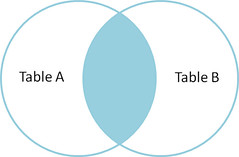 |
SELECT * FROM TableA Full outer join produces the set of all records in Table A and Table B, with matching records from both sides where available. If there is no match, the missing side will contain null. |
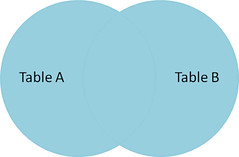 |
|
SELECT * FROM TableA Left outer join produces a complete set of records from Table A, with the matching records (where available) in Table B. If there is no match, the right side will contain null. |
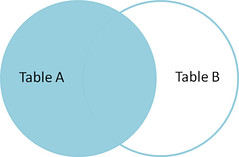 |
SELECT * FROM TableA To produce the set of records only in Table A, but not in Table B, we perform the same left outer join, then exclude the records we don't want from the right side via a where clause. |
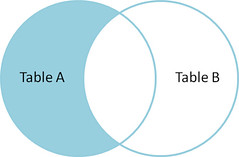 |
SELECT * FROM TableA To produce the set of records unique to Table A and Table B, we perform the same full outer join, then exclude the records we don't want from both sides via a where clause. |
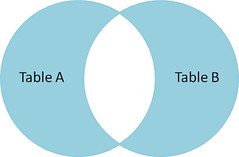 |
There's also a cartesian product or cross join, which as far as I can tell, can't be expressed as a Venn diagram:
SELECT * FROM TableA
CROSS JOIN TableB
This joins "everything to everything", resulting in 4 x 4 = 16 rows, far more than we had in the original sets. If you do the math, you can see why this is a very dangerous join to run against large tables.
 Del.icio.us
Del.icio.us Digg
Digg Reddit
Reddit Facebook
Facebook StumbleUpon
StumbleUpon
2 comments:
Thank you for sharing such a nice article.
chaussures puma
puma speed cat
Nike Tn Chaussures
requin tn
nike shox
puma shoes
puma CAT
puma basket
puma speed
baskets puma
puma sport
puma femmes
puma shox r4 torch
nike air max requin
nike shox r3
shox rival r3
tn plus
chaussures shox
nike shox r4 torch
air max tn requin
nike tn femme
pas cher nike
tn chaussures
nike rift
nike shox nz
chaussures shox
nike shox rival
shox rival
chaussures requin
jeans online
cheap armani jeans
cheap G-star jeans
But it can make your feeling cool, so simple life we can enjoys it. No complecated, no hard, no knows make yourselves happy.
Nike shox shoes can surely not let you down,romance yourself with nike shox
Post a Comment